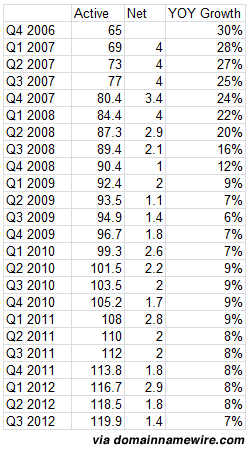Verisign Blames Google For Drop In Domain Registration & Renewal Rates
The number of new domains being registered, and existing domains being renewed, is slowing down and Verisign — the company that operates the .com and .net domain registries — says Google is a main reason why. On the company’s Q3 earnings call yesterday, Verisign shared the following data related to domain registrations and renewals: total […]

On the company’s Q3 earnings call yesterday, Verisign shared the following data related to domain registrations and renewals:
- total .com and .net domain registrations grew only one percent in Q3, below the company’s previous guidance to investors
- registrations of .net domains were down one percent from a year ago
- the domain renewal rate was 72.3 percent in Q3, down from 72.9 percent in Q2 and from 73.3 percent a year ago
The company gave two reasons for the slowness in registrations and renewals: “macroeconomic headwinds” in Europe and changes in search engine algorithms — more specifically, Google’s ongoing changes.
CEO and President D. James Bidzos spent considerable time discussing Google’s impact, and not just related to the recent EMD update that targeted exact-match domains with low quality content, but also Google changes as far back as 2009.
First of all, you recall that back in 2009, that was really the first time that we saw a major change in search algorithms that targeted the monetization players who were essentially trying to exploit the search engine algorithm to get themselves placed higher in results so that they can drive traffic and monetize it themselves.
We saw that over a period of time, after those changes, there was some recovery and the monetization community adapted to it. We saw in 2012, changes which affected Q2, which we’ve discussed with you before.
I think there is a more serious effort by the search engine algorithm players here to sort of clean up search results and improve the quality, as Pat said, to drive some of the monetization community down further. So we discussed in the last call, the Panda and Penguin programs, for example, that Google utilized where they were targeting content farms, they were targeting keyword stuffers and now, they’re also targeting exact name matches, which typically are monetization names often.
So for example, if you search for purple blue widgets, and purplebluewidgets.com happens to be a registered domain, that in the past, would’ve been likely to score very high in the search results. However, if the search engine algorithm is tweaked to go out and consider other factors, the age of the domain, how many pages are on it, how fresh is some of the contents and give it a score, essentially, on how likely it is that it’s truly quality content that the searcher might be interested in versus something that had been set up for monetization purposes, I think the search engine algorithms are essentially targeting that kind of traffic to get it out.
Domain Name Wire has compiled some interesting data in its coverage of the Verisign call, showing how new .com/.net registrations have dropped from four million every quarter back in 2007-2008 to 1-2 million per quarter now (see the “Net” column below). And the yearly growth in new registrations, which used to be in the 20-30 percent range, is now down below 10 percent.
Google’s Panda update and Penguin update could be said to impact domain registrations and renewals over the past couple years — Penguin was launched this past April, while Panda dates back to February 2011.
But what about 2009, when Verisign says it started seeing Google and search engine changes impact its business? Well, there was the Vince update in February of that year. At the time, Google referred to Vince as a “minor change” that relied more heavily on certain trust and quality signals. But to the search engine marketing industry, Vince was a change that favored brands and pushed them higher in Google’s search results. And that’s exactly the kind of change that would impact webmasters that were trying to make money online via new domains, parked domains and, really, any domain that didn’t meet Google’s standards for trust and quality.
In its call yesterday, Verisign told analysts that it expects to add between 0.9 million and 1.3 million new .com and .net domains in Q4 — down from the 1.4 million added in Q3.
Opinions expressed in this article are those of the guest author and not necessarily Search Engine Land. Staff authors are listed here.
Related stories
